Navigation
Install the app
How to install the app on iOS
Follow along with the video below to see how to install our site as a web app on your home screen.
Note: This feature may not be available in some browsers.
More options
You are using an out of date browser. It may not display this or other websites correctly.
You should upgrade or use an alternative browser.
You should upgrade or use an alternative browser.
Aztec Artifacts in the US ?
- Thread starter Samanthy
- Start date
BillA
Bronze Member
Am familiar with the copper from the Keweenaw,
where did 'native Americans' (as we like to refer to them) first smelt copper ore ? silver ore ?
Is smelting to be considered also as casting (open mold) ?
I am not aware that NAs did smelting, nor casting.
Is this correct ?
per Wiki, no casting or smelting done by native North Americans; a stone-age culture, neolithic
Charl
Silver Member
the first 2 do not correspond with the last (my opinion), why the need to make pretty?
stacked flat rocks at a steep angle were good enough for them, . . . .
In my opinion, they do correspond. Also, since I have visited quite a few Ancestral Puebloan ruins, both mesa top, as well as cliff dwellings, I should have known these people did use mud mortar in their constructions:
https://www.ocf.berkeley.edu/~peterson/docs/pueblo.html
Of course you're entitled to your opinion, but the Wupatki example is far from the only stone built ballcourt known. I believe it was restored to its original look. There was some disintegration of the surrounding wall, as would be expected after 700+ years. I don't think restoring it is due to any "imperative" to make it pretty. It was restored to its original appearance, and, its appearance as it was excavated made that very easy to do, IMO. I think the team knew exactly, through long experience and knowledge of such ballcourts, as well as the original condition of this one, what they were doing, and were completely faithful to the original....
Last edited:
joshuaream
Silver Member
per Wiki, no casting or smelting done by native North Americans; a stone-age culture, neolithic
South of modern day Mexico City it went on in several places. Probably at least 6 different major populations could cast metals.
BillA
Bronze Member
yea, I've knocked around the SW also - but I try not to confuse observing with knowing (not really even my opinion, see below)
"[FONT="]While the Mesoamerican ball courts were generally built out of stone, in the Arizona desert the Hohokam built theirs by digging into the desert and piling the soil up on either side. Some of the ball courts were 250 feet (76 meters) in length and 90 feet (27 meters) in width. In some instances they were dug up to 9 feet (nearly 3 meters) into the subsoil.[/FONT]"
from Hohokam Ball Courts | Native American Netroots
Obviously I saw, and commented on, the photos showing stacked rocks on the sides; more on the 'net through I could find no rocks in others.
not a biggie, much more photogenic this way
"[FONT="]While the Mesoamerican ball courts were generally built out of stone, in the Arizona desert the Hohokam built theirs by digging into the desert and piling the soil up on either side. Some of the ball courts were 250 feet (76 meters) in length and 90 feet (27 meters) in width. In some instances they were dug up to 9 feet (nearly 3 meters) into the subsoil.[/FONT]"
from Hohokam Ball Courts | Native American Netroots
Obviously I saw, and commented on, the photos showing stacked rocks on the sides; more on the 'net through I could find no rocks in others.
not a biggie, much more photogenic this way
BillA
Bronze Member
South of modern day Mexico City it went on in several places. Probably at least 6 different major populations could cast metals.
very good Joshua
we have Americans
we have South American, Central American (that's me), and North American
and North America includes The United States of Mexico, The United States of America, and Canada
now I attempted to identify the indians living in what was later called the United States of America
ok, you take me to task because I could not think of the North American term excluding Mexicans
oh, but wait the term Mexican does not distinguish . . . .
your field Josh
you have proven me wrong
Charl
Silver Member
I hope the OP, and others, don't mind this aside. It does relate to the subject at hand.
As a one time history instructor, I liked to tell my students that history consists of a great many time lines. We Americans, when we study our own history, from grade school up, usually start that time line with the Age of Exploration, followed by colonization, in particular that of the English, French, and Spanish, though the history of the American British colonies, the American Revolution, and down to the present. The time line, in other words, is largely Euro-centric where the US is concerned.
Imagine Mesoamerican civilization as another time line. We really know so little about it, compared to our own history. It took quite awhile, for instance, before Mayan writing was deciphered. And, although the Maya people still very much exist, their civilization, and that of the other Mesoamerican civilizations, does not. It would seem that time line ended with the Spanish conquest.
But, one reason I like Ancestral Puebloan culture so much is because they existed at the same time as the great civilizations to their south, and they were aware of them. Both trade items, and ideas, establish that fact. They were not politically controlled by any of those civilizations, but I believe it's fair to say they existed in the northernmost hinterlands or frontiers of those civilizations. And were influenced. Think of the presence of the horned or feathered serpent in the belief system and iconography of both Mesoamerica and the Ancestral Puebloan.
And the Ancestral Puebloan time line is not dead. It still lives, on the Hopi Mesas, the Rio Grande Pueblos, and Acoma, the so-called sky city. With building styles clearly similar and descended from the mesa top pueblos of centuries ago. And, the way I like to view it, the continued existence of Puebloan culture reflects, in some sense, the continued time line of Mesoamerica. Acoma, the sky city, was established in the 12th century, when those high civilizations still lived. Making it the oldest continuously occupied town in the United States. And those early settlers of Acoma were aware of those civilizations. Their respective time lines of history intersected in the hinterlands that is today's American Southwest. Just as today, Acoma's ancient time line intersects with the time line established by being citizens of the United States in present time.
I guess this is a highly personal perspective, but it just gives me pleasure, perhaps because I've been attracted to the Ancestral Puebloans for a lifetime, and especially attracted to their Hopi descendants, to visualize these still living communities, within our own borders, as a still living connection to the time line of ancient Mesoamerica.
Acoma:
Sky City Cultural Center & Haak'u Museum
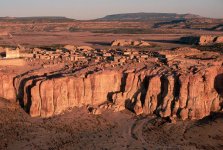
As a one time history instructor, I liked to tell my students that history consists of a great many time lines. We Americans, when we study our own history, from grade school up, usually start that time line with the Age of Exploration, followed by colonization, in particular that of the English, French, and Spanish, though the history of the American British colonies, the American Revolution, and down to the present. The time line, in other words, is largely Euro-centric where the US is concerned.
Imagine Mesoamerican civilization as another time line. We really know so little about it, compared to our own history. It took quite awhile, for instance, before Mayan writing was deciphered. And, although the Maya people still very much exist, their civilization, and that of the other Mesoamerican civilizations, does not. It would seem that time line ended with the Spanish conquest.
But, one reason I like Ancestral Puebloan culture so much is because they existed at the same time as the great civilizations to their south, and they were aware of them. Both trade items, and ideas, establish that fact. They were not politically controlled by any of those civilizations, but I believe it's fair to say they existed in the northernmost hinterlands or frontiers of those civilizations. And were influenced. Think of the presence of the horned or feathered serpent in the belief system and iconography of both Mesoamerica and the Ancestral Puebloan.
And the Ancestral Puebloan time line is not dead. It still lives, on the Hopi Mesas, the Rio Grande Pueblos, and Acoma, the so-called sky city. With building styles clearly similar and descended from the mesa top pueblos of centuries ago. And, the way I like to view it, the continued existence of Puebloan culture reflects, in some sense, the continued time line of Mesoamerica. Acoma, the sky city, was established in the 12th century, when those high civilizations still lived. Making it the oldest continuously occupied town in the United States. And those early settlers of Acoma were aware of those civilizations. Their respective time lines of history intersected in the hinterlands that is today's American Southwest. Just as today, Acoma's ancient time line intersects with the time line established by being citizens of the United States in present time.
I guess this is a highly personal perspective, but it just gives me pleasure, perhaps because I've been attracted to the Ancestral Puebloans for a lifetime, and especially attracted to their Hopi descendants, to visualize these still living communities, within our own borders, as a still living connection to the time line of ancient Mesoamerica.
Acoma:
Sky City Cultural Center & Haak'u Museum

southfork
Bronze Member
BillA
Bronze Member
This photo speaks for its self .
but with muted voice
when taken ?
original or stabilized/reconstructed ?
do you have access to older photos of the same ?
you guys are showing me what the park service builds for tourists
southfork
Bronze Member
BillA
Bronze Member
Charl, be interesting (for those who follow us) to see if these small tribal groups can maintain an identity while assimilating.
The same issues exist through out the Americas.
Phrased another way, are the remnants of the neolithic groups going to follow the others (into cultural extinction)?
edit:
southfork, mud chinking - ok, I'll stop
2ed edit: Charl
have an opinion on the book 1491 by Mann ?
The same issues exist through out the Americas.
Phrased another way, are the remnants of the neolithic groups going to follow the others (into cultural extinction)?
edit:
southfork, mud chinking - ok, I'll stop
2ed edit: Charl
have an opinion on the book 1491 by Mann ?
Last edited:
joshuaream
Silver Member
you have proven me wrong
Sorry Bill, I wasn’t attempting to prove anyone wrong. I was reading quickly and your reply/quote of your original post just read NA and I took that as Native American not North American. No snarkiness intended.
I do think it’s interesting, if the Native American groups in what is now the US hadn’t been interrupted by Europeans were they hundreds of years away from figuring out metal work? Would one of the bigger group from what is now Mexico take up an interest in the lands to the north? Wheels and sails weren’t used for transport, had they figured those out it would have had an interesting impact had the Aztecs made it to Cahokia.
Charl
Silver Member
yea, I've knocked around the SW also - but I try not to confuse observing with knowing (not really even my opinion, see below)
"While the Mesoamerican ball courts were generally built out of stone, in the Arizona desert the Hohokam built theirs by digging into the desert and piling the soil up on either side. Some of the ball courts were 250 feet (76 meters) in length and 90 feet (27 meters) in width. In some instances they were dug up to 9 feet (nearly 3 meters) into the subsoil."
from Hohokam Ball Courts | Native American Netroots
Obviously I saw, and commented on, the photos showing stacked rocks on the sides; more on the 'net through I could find no rocks in others.
not a biggie, much more photogenic this way
Yes, Hohokam ballcourts were earthern, not stone. The Wupatki pueblo ballcourt is Sinagua culture, as are the other pueblo ruins in Wupatki National Monument, as well as the well known Montezuma's Castle cliff dwelling, and the Tuzigoot pueblo, the latter two located in the Verde Valley of Az.
Last edited:
BillA
Bronze Member
the metal working technology's route from South to North America (Mexico) is well known
and the cultures/civilizations of the south were considerably more advanced than in the north
jade was the maximo, until gold (castings) showed up; culture after culture
here in CR there are reworked Maya jade pieces, I know of no similar trade to the north
technology rests on a base, a lot more than a couple hundred years of rest time to catch-up
apparently the multi-decades droughts spiked whatever the 'indians' could get together
and the cultures/civilizations of the south were considerably more advanced than in the north
jade was the maximo, until gold (castings) showed up; culture after culture
here in CR there are reworked Maya jade pieces, I know of no similar trade to the north
technology rests on a base, a lot more than a couple hundred years of rest time to catch-up
apparently the multi-decades droughts spiked whatever the 'indians' could get together
Charl
Silver Member
Yes, Hohokam ballcourts were earthern, not stone. The Wupatki pueblo ballcourt is Sinagua culture, as are the other pueblo ruins in Wupatki National Monument, as well as the well known Montezuma's Castle cliff dwelling, and the Tuzigoot pueblo, the latter two located in the Verde Valley of Az.
Speaking of Tuzigoot, Wupatki, and other Sinagua sites, and trade with Mesoamerica, enter the beautiful Scarlet Macaw:
https://amberpolo.blogspot.com/2017/10/sacred-scarlets-scarlet-macaws-big.html
"After hundreds of years Scarlet Macaws can again be seen at the ancient pueblos of the Verde Valley. Their dazzling feathers catching the sun under the Arizona skies. Remains of macaws have been documented in early archaeological excavations at both Montezuma Castle and Tuzigoot National Monuments. The birds were traded into the Verde Valley from hundreds of miles south in modern day Mexico. Substantial numbers of macaws were identified at Pueblo Bonito (Chaco Canyon) and Wupatki at least as early as 1,000 CE. The earliest date for Chaco (Pueblo Bonito) is approximately late 8th century to early 9th century. The date for Wupatki is approximately 1135-1195."
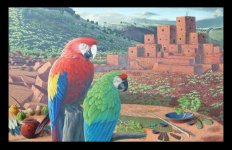
Tuzigoot Pueblo:
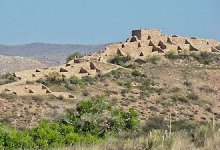
https://www.grandcanyontrust.org/info/tuzigoot-national-monument
The remains of Scarlet Macaws have been found at Chaco Canyon in New Mexico, at Hohokam sites, as well as other Pueblo building culture groups. It's long been assumed that this was the result of long distant trade from southern Mexico/Central America.
But, recent research indicates there may have been a breeding center located somewhere in northern Mexico. The Casas Grandes Pueblo( also known as Paquime, and located in northern Mexico), a huge Pueblo village of some 2000 rooms, bred Scarlet Macaws, but the remains found in the Southwest are older then Casas Grandes. (Casas Grandes was a huge trading center in the 1250-1450 time period, and may have served as a trading intermediary between the SW cultures and Mesoamerica). But now, DNA analysis of macaw remains point to an earlier, unknown breeding center:
https://www.nationalgeographic.com/...t-dna-chaco-canyon-pueblo-macaws-archaeology/
https://www.pnas.org/content/115/35/8740
Last edited:
IMAUDIGGER
Silver Member
- Mar 16, 2016
- 3,398
- 5,195
- Primary Interest:
- All Treasure Hunting
out of curiosity (my response is above, #32); are you concerned with the characterization of Christianity, or alcohol ?
edit: or just disputing magnitudes ?
(none of which are particularly relevant I do agree)
Attacking someone's religion is rude. I thought that was pretty straight forward.
This forum isn't the place to debate religion or the magnitude of various genocides.
Last edited:
MosesOfTheSouth
Full Member
i don't know if this is applicable to the metal conversation. i have one personal NA metal find that appears to have been roughly cast in some way. the metal is non-ferrous, doesn't respond to a magnet, and also quite heavy. the metal ring came from the same level as benton and other archaic type points. i haven't really seen anything else like it .
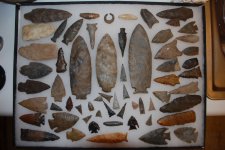
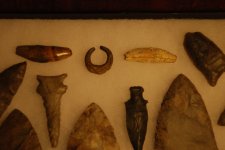
it's obviously no where near the refinement of metal working seen in some of the other cultures, still really interesting.


it's obviously no where near the refinement of metal working seen in some of the other cultures, still really interesting.
BillA
Bronze Member
MOTS impressive display case, no way to get more info on the ring ? (for scale, what is the gap measurement ? approx)
copper would be implied and pieces were traded far from NE
is the ring from TN ? (a lot closer to New England than Central Mexico)
I am kind of fishing for indications of smelting ore (cooked rocks, matching slag, etc.).
Nothing seems known in the US/Canada, and the late occurrence in Central Mexico leads me to suspect it was not indigenous to Mexico.
Any pre-colonial Mexico experts ? (starting with the well known cultures/artifacts) Where was hoe money first smelted in Mexico ?
copper would be implied and pieces were traded far from NE
is the ring from TN ? (a lot closer to New England than Central Mexico)
I am kind of fishing for indications of smelting ore (cooked rocks, matching slag, etc.).
Nothing seems known in the US/Canada, and the late occurrence in Central Mexico leads me to suspect it was not indigenous to Mexico.
Any pre-colonial Mexico experts ? (starting with the well known cultures/artifacts) Where was hoe money first smelted in Mexico ?
MosesOfTheSouth
Full Member
MOTS impressive display case, no way to get more info on the ring ? (for scale, what is the gap measurement ? approx)
copper would be implied and pieces were traded far from NE
is the ring from TN ? (a lot closer to New England than Central Mexico)
I am kind of fishing for indications of smelting ore (cooked rocks, matching slag, etc.).
Nothing seems known in the US/Canada, and the late occurrence in Central Mexico leads me to suspect it was not indigenous to Mexico.
Any pre-colonial Mexico experts ? (starting with the well known cultures/artifacts) Where was hoe money first smelted in Mexico ?
i just got stung by a bee taking the pictures hahaha.
yes from tennessee. the metal type is tough, seems to almost be a mix to it, or crude refinement. doesn't have a patina that would be likely for lead. no smell/taste to it either.
it weighs 13.3 grams and a quarter in the fist pic for size reference.
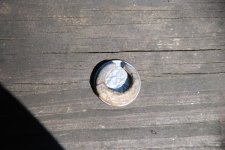
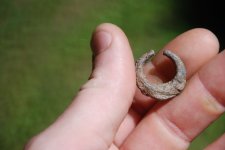
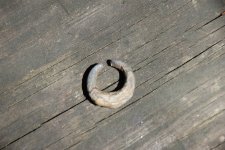
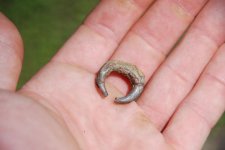
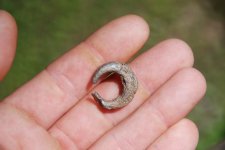
Last edited:
BillA
Bronze Member
curious, no trace of green, seems an outside layer has formed/spalled off ?
grey color, what is the purple layer in #4 ?
nose ring ? did the locals use such ?
grey color, what is the purple layer in #4 ?
nose ring ? did the locals use such ?
Top Member Reactions
-
 3358
3358 -
 1989
1989 -
 1932
1932 -
 1164
1164 -
 1096
1096 -
 890
890 -
 806
806 -
 797
797 -
 794
794 -
 788
788 -
 751
751 -
 537
537 -
 484
484 -
 460
460 -
 444
444 -
 425
425 -
 422
422 -
 420
420 -
E
409
-
 383
383
Users who are viewing this thread
Total: 2 (members: 0, guests: 2)







